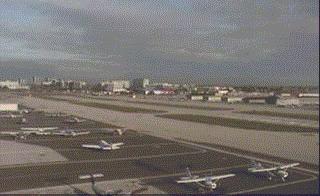by Vance Cochrane, CFI-I, ME-I at Diamond Aviation
Everyone knows that San Carlos is actually old Spanish for “Saint Crosswind.” Seriously, you can usually, depending on the time of day, expect to have a crosswind when landing at San Carlos Airport.
 In the morning, the air is usually quite still and the tower will assign runway 12. (This limits the noise effects to our neighbors at Redwood Shores.) Most of the time, there is not much of a crosswind on 12. There are no significant structures near the approach end of runway 12 to make much of a difference in the wind patterns. (Some may argue that Houlihan’s is a significant structure, but I won’t comment on what some pilot’s do after the flying day is over.)
In the morning, the air is usually quite still and the tower will assign runway 12. (This limits the noise effects to our neighbors at Redwood Shores.) Most of the time, there is not much of a crosswind on 12. There are no significant structures near the approach end of runway 12 to make much of a difference in the wind patterns. (Some may argue that Houlihan’s is a significant structure, but I won’t comment on what some pilot’s do after the flying day is over.)
 As the morning progresses, the winds will begin to pick up a little out of the north and thus, after enough people have landed long and hot, the tower will assign runway 30. Now here the situation is a little different. For a long time, there was not much near the approach end of 30 to play with the prevailing wind. There is the little berm near the walking path and sometimes the wind kicks up there giving a little burble. I’m sure many of you have experienced this. Now however, things will begin to change for crosswind landings at runway 30.
As the morning progresses, the winds will begin to pick up a little out of the north and thus, after enough people have landed long and hot, the tower will assign runway 30. Now here the situation is a little different. For a long time, there was not much near the approach end of 30 to play with the prevailing wind. There is the little berm near the walking path and sometimes the wind kicks up there giving a little burble. I’m sure many of you have experienced this. Now however, things will begin to change for crosswind landings at runway 30.
As you have already seen, an office building complex is being constructed immediately west of the approach end of runway 30. When the wind is from the west (or left side), and you are landing on runway 30 the presence of these buildings will likely cause turbulent burbles at or near your touchdown zone. What exactly will it do? Well, we don’t know yet. (As construction continues, are we becoming “Test Pilots?”) In a really significant wind, we may enter a zone of calm air as we get close to the runway which may introduce a little wind shear if we are not careful with our approach speeds. Remember use the appropriate methods for landings in a significant wind, which usually amounts to adding half the gust factor to your approach speed. Thus, if you hit an area of calm/dead air you have the extra cushion available. For the benefit of other aircraft in the pattern be sure to report any unusual conditions to the tower.
 There is no special technique to landing in a crosswind at San Carlos Airport. Normal crosswind methods, either the crab or side slip will work. Do which ever you feel comfortable doing. I have had many students who prefer to crab, while other prefer to slip. The important thing is to land safely within your capabilities, so use your best technique. Another thing about landing at San Carlos is don’t be afraid to request the appropriate runway for landing or departure based on the wind. I can’t tell you the number of times I have been in the Sky Kitchen Restaurant watching Katanas, Cessna 172s and other lightly wing-loaded airplanes making F-104 approaches to runway 12 due to a 5 knot tailwind! Remember, you are the pilot-in-command and if you feel that the runway should be 30, ask for it! Don’t let the tower guys intimidate you. You can tell them which runway you want. Just make sure that your request is a reasonable one. They can either grant your request or deny it, but you will get the point across. Since we sometimes have green controllers (as well as green pilots) we occasionally need to guide them in the right direction.
There is no special technique to landing in a crosswind at San Carlos Airport. Normal crosswind methods, either the crab or side slip will work. Do which ever you feel comfortable doing. I have had many students who prefer to crab, while other prefer to slip. The important thing is to land safely within your capabilities, so use your best technique. Another thing about landing at San Carlos is don’t be afraid to request the appropriate runway for landing or departure based on the wind. I can’t tell you the number of times I have been in the Sky Kitchen Restaurant watching Katanas, Cessna 172s and other lightly wing-loaded airplanes making F-104 approaches to runway 12 due to a 5 knot tailwind! Remember, you are the pilot-in-command and if you feel that the runway should be 30, ask for it! Don’t let the tower guys intimidate you. You can tell them which runway you want. Just make sure that your request is a reasonable one. They can either grant your request or deny it, but you will get the point across. Since we sometimes have green controllers (as well as green pilots) we occasionally need to guide them in the right direction.
Here are some other tips to remember when landing at ANY airport:
- Use the ATIS (if available), but take it with a grain of salt. A little head work from the ATIS information can tell you what kind of crosswind you may expect when landing. Don’t let this become a preconceived notion of what the wind is actually doing. Remember that ATIS could be almost an hour old and the wind direction and velocity may have changed!
- What does your plane want to do on downwind? In order track parallel to the runway, are you in a crab? This may be an indication of what the wind is going to be on final.
- What does the windsock say? Even if there is a tower, you should look at the windsock as that is real-time information of the best quality. I wish every airport had a windsock.
- What does the plane want to do on final? This is the best method if there is no windsock. Just see if the plane wants to crab one way or the other while lined up with the runway and you’ve got your crosswind direction.
- Don’t be shy about asking the tower (if available) for the current winds.
- Finally, don’t be afraid to make a go-around if you’re not happy with your speed, drift control and position while on final approach. Be sure to stabilize the airplane in the climb and then call the tower to tell them you are making a go-around.
Remember: Winds at San Carlos Airport can be tricky and anyone who isn’t proficient and comfortable in dealing with all the issues I’ve dealt with in this article should get some serious dual instruction.
That’s it for now and remember: Every landing is a crosswind landing, only the component changes!

